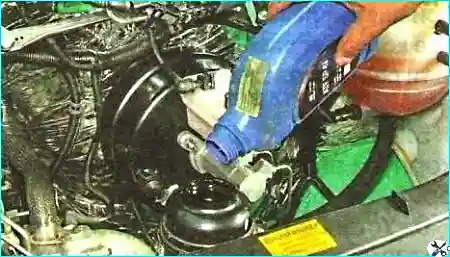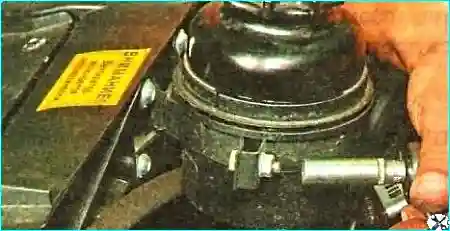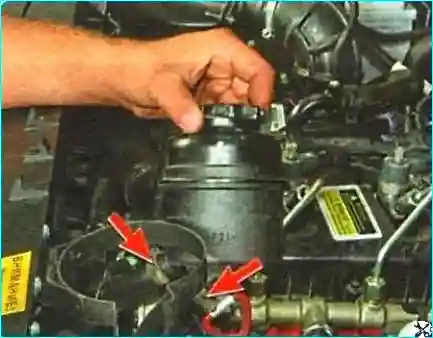Bleeding the hydraulic system of the power steering is necessary after any work related to depressurization of the system (replacing the pump or pipelines)
A sign of the presence of air in the system is the jamming of the steering wheel when trying to turn it sharply.
In addition, the pump makes increased noise when turning the steering wheel, and the fluid in the tank usually foams.
Brake the car with the parking brake and install wheel chocks under the rear wheels.
Lift the front of the car and place it on reliable supports so that the front wheels do not touch the ground.
If you have a lift, you can lift the entire car.

Fill the power steering system with working fluid up to the lower mark on the dipstick installed in the tank cap
Without starting the engine, turn the steering wheel five or six times to the left and right until it stops.
Start the engine and turn the steering wheel until it stops in one direction. Do not increase engine speed above idle speed.
Do not hold the steering wheel in the extreme position for more than 5 seconds.
Turn the steering wheel all the way in the opposite direction.
Return the steering wheel to the center position and turn off the engine.
Check the level of the working fluid in the power steering reservoir and add fluid if necessary.
When the engine is warm, the working fluid level in the reservoir should not be higher than the upper mark on the dipstick, and when the engine is cold, it should not be lower than the lower mark.
Repeat steps 4-7 until the fluid level in the reservoir stops decreasing when the steering wheel is turned and air bubbles stop appearing in the fluid.
Add the required amount of working fluid. Do not pour the fluid above the upper mark.
Lower the front wheels to the ground. Start the engine and turn the steering wheel several times from one extreme position to the other.
Make sure that the difference in fluid levels in the reservoir when turning the steering wheel left and right is insignificant.
Make sure that the difference between the fluid level with the engine running and the level after the engine is stopped is within 5 mm.
If the difference in levels has reached 5 mm or more, then the air has not been completely removed from the system and you should repeat bleeding.
Replace the reservoir cap and wipe off any fluid leaks.
Replacing the power steering fluid
According to the manufacturer's recommendation, the fluid in the power steering system is not changed during the entire service life of the vehicle.
However, if the fluid in the reservoir is heavily contaminated or darkened, it should be replaced.
When If the fluid is heavily contaminated or darkened, check the serviceability of the power steering pump and steering gear. They may need to be repaired or replaced.
Lift the front of the car and place it on reliable supports so that the front wheels do not touch the ground.
If you have a lift, you can lift the entire car.
Pump out (for example, with a syringe or rubber bulb) the fluid from the power steering reservoir.

Unscrew the nut of the clamping bolt of the tank mounting bracket and remove the bolt from the bracket hole
Remove the tank from the bracket, loosen the clamp of the fluid return hose and disconnect the hose

Lower the end of the disconnected hose into a previously prepared container.
If the hose is not long enough, extend it with a section of any hose of a suitable diameter.
Drain the fluid from the power steering system by starting the engine two or three times for a few seconds and simultaneously turning the steering wheel alternately in both directions until it stops.
Connect the fluid return hose to the power steering reservoir.
Pour fluid into the reservoir and bleed air from the power steering system.
Do not overfill the fluid above the upper mark on the dipstick.
Reinstall the plug and wipe off any leaks.





